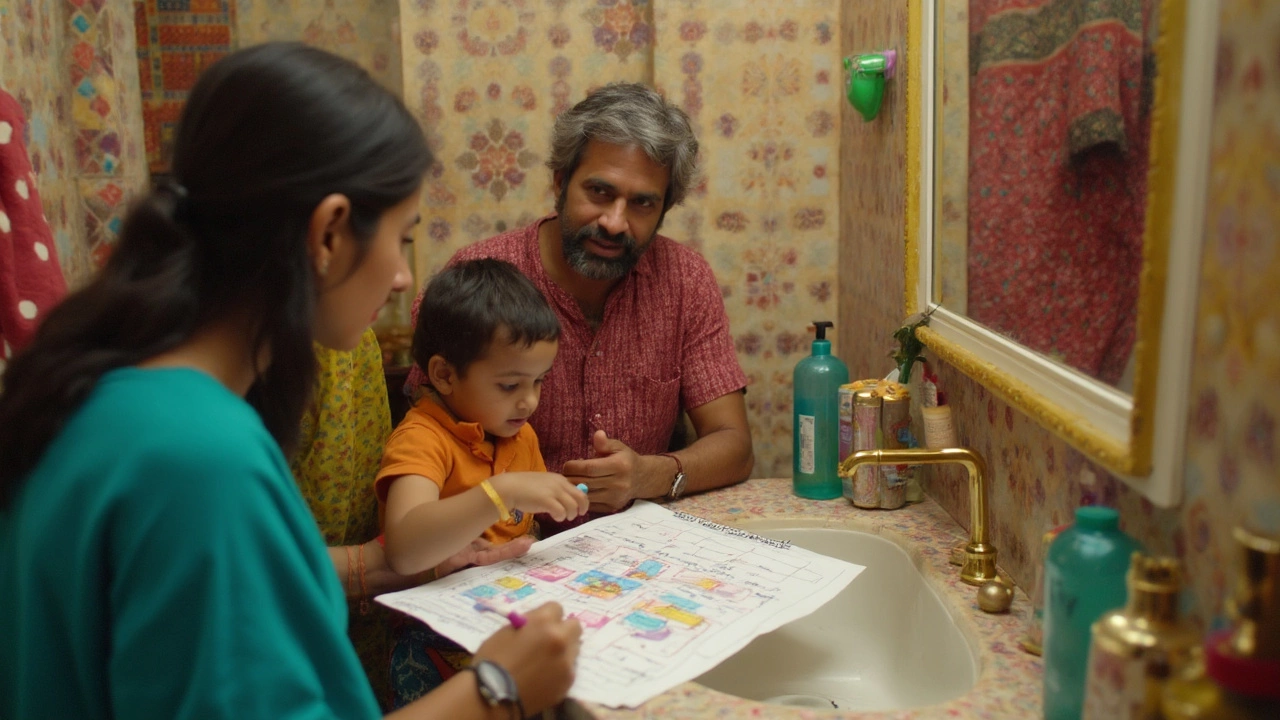If you’re planning a small bathroom renovation, you’re probably asking, 'How long is my place going to be a construction zone?' You’re not alone—no one wants the shower out of order for weeks on end. The truth? A typical small bathroom refit takes about two to three weeks from start to finish if you hire a good contractor and nothing wild pops up. If you’re tackling it yourself or there are unexpected surprises behind the tiles, it can drag out—for a month or more.
But hang on, there’s a pattern to these projects. Knowing exactly what needs doing saves you from guesswork and blown-up schedules. The main phases are planning, demolition, fixing any issues behind the walls, installing new stuff, then the finishing touches. Each step is pretty predictable if you don’t hit a nasty leak, ancient wiring, or that mystery pipe nobody mentioned.
Before you start swinging a sledgehammer, have every detail nailed down. Pick your tiles, taps, and lights early. Order supplies ahead of time—waiting for a “backordered” vanity is a renovation killer. Good prep trims days—even weeks—off your reno. Even if your space is smaller than your closet, getting this stuff sorted first is honestly half the battle.
- Breaking Down the Timeline
- Key Steps in a Small Bathroom Renovation
- What Usually Delays the Process?
- Speeding Things Up: Smart Tips
- DIY vs Pro: Does It Change the Schedule?
- Final Walkthrough and Moving In
Breaking Down the Timeline
A lot of folks guess small bathroom renovations can finish in a week. In reality, they usually land closer to two or three weeks if everything clicks into place. That’s assuming you’ve got a contractor lined up, all materials are in your garage, and there’s no need for major plumbing or electrical rerouting. The big thing to remember? That timeline starts after all your decisions are made and parts have arrived.
Here’s how a typical schedule for a small bathroom renovation might look from day one to final clean-up:
- Days 1-2: Prep and Demo – Removing old tiles, fixtures, and maybe busting out an old tub. This is fast if there’s no unexpected mess inside the walls.
- Days 3-5: Rough-In Work – Plumbers and electricians run new lines or update old ones. If you’re moving things around, expect this phase to last longer.
- Days 6-8: Wall Repair and Floors – Fixing walls, drywall, cement boards, then laying down new flooring. Waiting for things like grout or mud to dry can tack on a day here.
- Days 9-12: Tile and Paint – Tiling the shower and walls, then painting the new drywall. Pros knock it out fast, but DIY jobs may take longer since you’ll need to let stuff dry in between steps.
- Days 13-15: Fixtures, Fittings, and Finishing Touches – New vanity, toilet, lighting, towel bars, and mirrors all go in. This is where you finally see it all coming together.
- Day 16+: Final Touch-Ups and Clean Up – Minor fixes, sealing, and making sure everything’s spotless before you move in your toothbrush.
If your contractor juggles a bunch of projects or if materials show up late, this can stretch out. Permits or inspections, especially in older homes or city apartments, might add another week before you can hang your towels. It’s smart to build in a 'buffer zone' of three to five extra days after your target deadline. That way, plumbing leaks or delayed tile shipments won’t throw you off completely.
Key Steps in a Small Bathroom Renovation
Renovating a small bathroom follows a pretty clear order. Skipping steps or tackling them in the wrong order only causes delays and extra costs. Here’s how pros and savvy DIYers keep things moving:
- Plan Everything Upfront – This step isn’t just picking out tile colors. It’s measuring, double-checking your layout, deciding on exactly what you want replaced, and making a product list. If you’re working with a contractor, they’ll probably need every detail confirmed—from taps to towel bars—before swinging a hammer.
- Demolition – Once your plan is set, out goes the old. Demo usually means tearing out tiles, removing fixtures, and possibly gutting walls if you’re relocating plumbing or chasing out mold. It can be loud and messy, but it’s fast—often done in a day or two.
- Rough-In Work – This is where the magic (or drama) happens behind the walls. Plumbers and electricians come in to move pipes, add outlets, or upgrade wiring. If your house is older, updates here sometimes reveal extra problems, so budget some cushion time. Proper rough-in work sets you up for a safe, code-compliant renovation.
- Install Surfaces – Walls get put back together with cement board or drywall, then tiling starts. Floors, showers, and backsplashes all get done at this stage. Tiling is one area where details count—rushed work shows badly in a small space. Every line is in plain sight.
- Fixture Fit-Out – Now comes the fun part: installing the new toilet, sink, tub, and hardware. Each one has to fit back into place cleanly, so double-check you got the right sizes. Small bathrooms have little room for error here.
- Finishing Touches – Paint, caulk, mirrors, lights, shelves, and sealant wrap things up. Don’t rush this. One missed bead of caulk can cause leaks down the line. Double-check everything works, no drips or flickering lights. Punch lists help here; walk through with your contractor or by yourself.
That’s the real flow of a small bathroom renovation. Following this order keeps costly mistakes to a minimum and gets you through the mess faster.
What Usually Delays the Process?
Even with the best planning, things can go off track in a small bathroom renovation. Most delays actually come from a handful of sources that you can spot early if you know what to look for.
Hands down, one of the top hold-ups is waiting for materials. Not every tile or vanity is sitting in a warehouse nearby. Custom stuff can take weeks. According to a report from HomeAdvisor, "about 35% of bathroom renovation delays are caused by material backorders or shipping hiccups." Ever seen a contractor twiddling his thumbs waiting for a faucet? Yeah, it’s real and it’s frustrating.
"Unplanned plumbing or electrical issues are the most common surprises in a bathroom remodel, and they can extend the project by days or even weeks." — National Association of the Remodeling Industry (NARI)
Here are some usual suspects that can slow down your bathroom job:
- Hidden damage: Behind old tiles, sometimes there’s water damage, rot, or ancient pipes. Sorting that out isn’t quick.
- Permits and inspections: If your project needs city approval, you could be waiting for sign-offs at each step—these aren’t always speedy.
- Unreliable trades: If your plumber or tiler runs late, everything piles up. It’s like dominos.
- Change of plans: Deciding to swap that shower for a soaking tub mid-project? That resets your entire timeline.
- DIY learning curve: Doing parts yourself is awesome for the wallet, but it never moves as fast as professionals.
Here’s a look at where most delays pop up in small bathroom remodels, according to the National Kitchen and Bath Association (NKBA):
| Delay Source | Percent of Projects Affected | Average Days Added |
|---|---|---|
| Material Delays | 38% | 7-14 days |
| Permit/Inspection Slowdowns | 24% | 3-10 days |
| Hidden Water Damage | 21% | 5-12 days |
| Contractor Scheduling | 17% | 2-7 days |
So basically, the biggest tip is to expect a hiccup or two. Order your stuff early, check behind walls before demo, and get your paperwork done ahead of time. It beats showering at the gym for another week.

Speeding Things Up: Smart Tips
You want that bathroom sorted fast, right? The biggest secret—get everything ready before you start. Seriously, pre-order every major item like tiles, fixtures, lights, and even the grout. Waiting for that one weird-size sink holds up the whole job. Hardware stores sometimes run out of basic plumbing fittings, so double-check all the parts are actually in your hands.
Next, book your contractor before demolition. Good tradespeople fill their calendars in advance. If you’re doing parts yourself, line up help for the messier bits (plumbing and electrical) so you’re not begging for a last-minute favor. A study from the National Kitchen & Bath Association in 2023 showed projects with pre-booked trades finished 27% quicker on average.
Don’t change your mind once the project kicks off. Every tweak means delays, reordering, and sometimes new permits. Lock in your plan and stick with it. You’ll thank yourself later.
- small bathroom renovation pros say: keep your old layout to avoid moving pipes or wiring—it saves money, time, and headaches.
- Schedule deliveries 2-3 days before you need them, not the day of. Delays in deliveries are a top reason renovations stall out.
- Get rid of old materials and debris daily. A clean space means trades can work faster without tripping over last week’s rubbish.
- Use quick-set adhesives and grouts where possible; they cut tile installation time by nearly half.
- If you have one bathroom, arrange for a portable toilet or stay with family—contractors hustle when nobody’s waiting on the loo.
Here’s a quick look at how each step affects the total time, based on real contractor data:
| Renovation Step | Avg. Days Needed | Tips to Speed Up |
|---|---|---|
| Demo & Prep | 1-2 | Clear out beforehand |
| Plumbing & Electrical | 2-3 | Have permits/parts ready |
| Tile & Walls | 3-4 | Use quick-set products |
| Install Fixtures | 2 | Unbox & check for damage early |
| Paint & Finish | 1 | Use fast-dry paint |
If you’ve got all your ducks in a row, you’ll breeze through the whole process and avoid the classic "why isn’t it done yet?" panic. It’s more boring prep than magic, but your timeline will thank you.
DIY vs Pro: Does It Change the Schedule?
Deciding whether to DIY or hire a pro for your small bathroom renovation has a huge impact on how long it’ll take. If you’re thinking about rolling up your sleeves, remember: even if you binge-watch YouTube tutorials, things almost always go slower than you expect. Realistically, a weekend warrior working evenings and weekends is looking at 4 to 8 weeks for a full bathroom redo. Meanwhile, a seasoned crew can often knock it out in two or three weeks, provided everything’s lined up and there aren’t any major surprises.
Here’s a side-by-side look at typical timeframes for small bathroom renovation projects:
| Task | DIY | Pro |
|---|---|---|
| Demo | 2-4 days | 1 day |
| Plumbing/Electrical | 5-7 days | 2-3 days |
| Tile & Wall Repair | 7-10 days | 3-4 days |
| Fixture & Vanity Install | 4-6 days | 2 days |
| Painting & Finish | 2-3 days | 1 day |
Hiring a pro might cost more upfront, but they move faster for two reasons: they do this all the time, and they know how to handle the headaches that slow rookies down. Also, if something needs a permit, licensed pros can sort it out faster than you can Google the rules. In some cities, pros will even coordinate with inspectors so you’re not waiting days for a green light.
If you’re determined to DIY, be honest about your skills and how much time you actually have. It helps to split big jobs into manageable weekend chunks. But if you need your bathroom back fast, or you don’t want to spend half your summer troubleshooting leaks, hiring pros is usually the way to go. The more complicated the plumbing or wiring, the bigger the risk—and the longer it’ll drag out if you’re learning on the fly.
- Pros have teams, tools, and experience.
- DIY can save money, but there's a real risk of it taking twice as long.
- Complicated tasks (like moving pipes or rewiring) almost always run smoother with a professional.
The bottom line: Want it quick and clean? Pay a pro. If you’re cool with dust, delays, and a little chaos for the sake of savings, DIY might be for you.
Final Walkthrough and Moving In
Right before you start using your spiffy new bathroom, there’s one last step you don’t want to skip—the final walkthrough. This is when you look at every detail with your contractor (or a sharp-eyed friend if you went the DIY route) to make sure the small bathroom renovation actually turned out how you wanted. You'd be surprised how many folks gloss over this step and end up spotting issues only after moving back in.
Start by testing everything: turn the faucets on and off, flush the toilet, run the shower, and see if anything leaks. Check if all lights and outlets work. Open and close all cabinet doors and drawers to make sure they don't stick or squeak. If you notice grout gaps, chipped tiles, or weird noises from behind the walls, speak up now. Fixes are way easier before you bring your toothbrush and towels back.
"The final inspection is your last chance to catch problems before move-in. Treat it like an investment in peace of mind," says Mike Holmes, well-known contractor and host of Holmes on Homes.
It’s smart to keep a quick checklist during your final walkthrough:
- Test all plumbing (sinks, toilet, tub/shower) for leaks or weird sounds
- Flip every switch and test every outlet
- Look for loose tiles or missing grout
- Inspect trim, caulk lines, and paint (no messy edges or smudges)
- Check that hardware (towel bars, hooks, shelves) is secure
Now, here’s something most people miss: keep your receipts and paperwork handy for any warranties. Many bathroom fixtures come with coverage lasting 1 to 5 years. You’ll thank yourself if something goes wrong later.
Wondering how long the move-in takes? Once you’ve signed off during the walkthrough, you can usually move your stuff in the same day—assuming any caulking or flooring doesn’t need extra drying. Check this small data table for an idea of typical wait times:
| Item | Average Dry/Cure Time |
|---|---|
| Fresh caulk or grout | 24-48 hours |
| Laminated floor glue | 24 hours |
| Latex paint | 2-4 hours to touch, 24 hours full cure |
Bottom line: don’t skip the walkthrough, pay attention to drying times, and keep your warranties straight. That’s how you make sure your small bathroom renovation goes from 'construction zone' to ‘wow’ without last-minute hassles.






